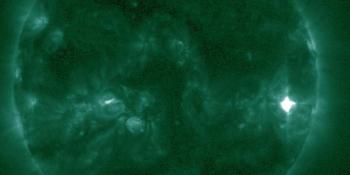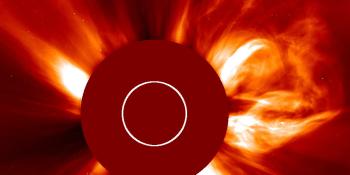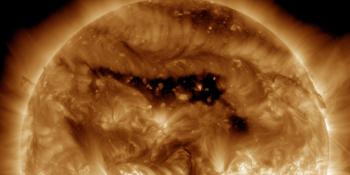M3.7 solar flare, Earth-directed CME
Saturday, 25 February 2023 10:40 UTC

A gorgeous filament eruption around sunspot region 3229 yesterday resulted in a M3.7 solar flare (R1-minor) that peaked at 20:30 UTC.
The event launched an asymmetrical full halo coronal mass ejection into space as seen by SOHO/LASCO. The bulk of the eruption is heading north-west and the halo outline is rather faint but it is likely that we will see an impact at Earth in the first half of 27 February. There have been no official forecasts out yet but minor G1 geomagnetic storm conditions (Kp5) seem likely, with a lesser chance of moderate G2 geomagnetic storm conditions.
Today's M3.7 solar flare was associated with this gorgeous filament eruption around sunspot region 3229. A coronal mass ejection was launched and we await further imagery to determine if there is an earth-directed component. pic.twitter.com/RW3Br2zJGx
— SpaceWeatherLive (@_SpaceWeather_) February 24, 2023
Yesterday's M3.7 solar flare launched an asymmetrical full halo coronal mass ejection into space as seen by SOHO/LASCO. The bulk of the eruption is heading north-west and the halo outline is rather faint but it is likely that we will see an impact at Earth on 27 February. pic.twitter.com/JP2SCZo199
— SpaceWeatherLive (@_SpaceWeather_) February 25, 2023
Sunspot regions 3234 and 3236
Sunspot region 3229 obviously took the spot light yesterday but we have two more regions which we really should keep an eye on. Both sunspot region 3234 and 3236 have magnetic delta structures which are tell tale signs that they could produce significant solar flares. These regions are fairly quiet at the moment but both have the potential to produce M-class activity.
Thank you for reading this article! Did you have any trouble with the technical terms used in this article? Our help section is the place to be where you can find in-depth articles, a FAQ and a list with common abbreviations. Still puzzled? Just post on our forum where we will help you the best we can!
Latest news
Latest forum messages
Support SpaceWeatherLive.com!
A lot of people come to SpaceWeatherLive to follow the Sun's activity or if there is aurora to be seen, but with more traffic comes higher server costs. Consider a donation if you enjoy SpaceWeatherLive so we can keep the website online!

Space weather facts
| Last X-flare | 2024/12/08 | X2.2 |
| Last M-flare | 2024/12/15 | M3.0 |
| Last geomagnetic storm | 2024/11/10 | Kp5+ (G1) |
| Spotless days | |
|---|---|
| Last spotless day | 2022/06/08 |
| Monthly mean Sunspot Number | |
|---|---|
| November 2024 | 152.5 -13.9 |
| December 2024 | 100.9 -51.6 |
| Last 30 days | 119.6 -37.2 |


